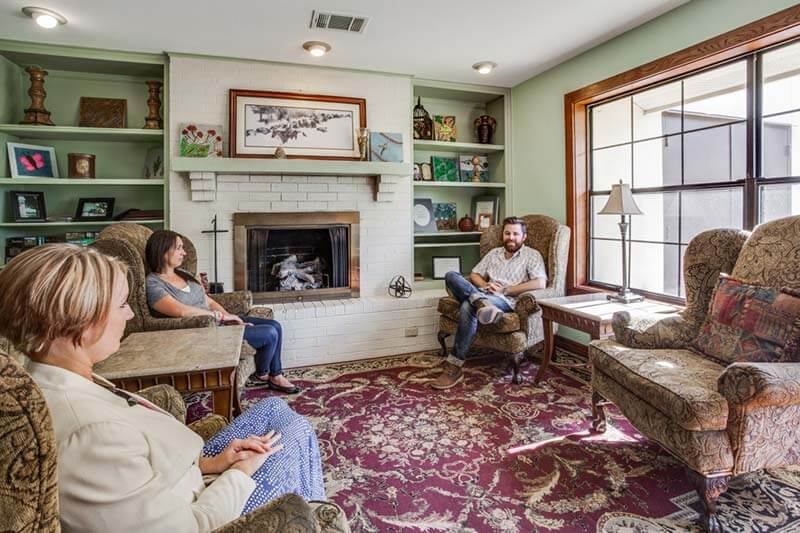About the History of Santé Center
In early 1996, renowned therapists Deb Corley and Rip Corley, a brother and sister team, operated a poly-addiction treatment program in a psychiatric hospital in Dallas, Texas. Deb was a licensed marriage and family therapist, sex offender treatment provider, chemical dependency counselor, and certified addiction therapist, and Rip was a nurse and social worker. As was fairly common in the 1990s, the psychiatric hospital was sold, and Rip and Deb were faced with the challenge of new administrators who wanted to cut key, efficacious components of their program. They knew they did not want to continue to work for companies where all decisions were based on what was best for the company instead of what was best for the client. Being mavericks committed to delivering effective treatment, the idea hatched to open their own addiction treatment center – one where long-term recovery was possible and realized.
The Corley’s discovered a beautiful piece of property sitting on the peak of rural Denton County with a gorgeous view. The former 16-acre horse ranch had been converted into an exclusive disordered eating spa that had long been abandoned; the only inhabitant in 1996 was a feline named Sammy. Even then everyone agreed that this was sacred ground, having an almost tangible spiritual nature to property; the potential of the property mirrored the potential in all the clients who would enter Santé’s gates.
After securing funding from a sympathetic loan officer who had knowledge of their work and the importance of treatment, the Corley siblings took their vision, principles and cornerstone of integrity and recruited a talented, dedicated and diverse team of professionals. Together they rallied around the ideas that treatment does work, that everyone deserves to be treated with dignity and that Santé could make a difference in countless lives. This was a true collaboration of integrity and clinical prowess to bring healing to the complex patient. The legacy began…

After considerable communication, education, negotiation and assurances to the small Argyle community, Santé was granted a license and opened for business in December 1996 with four clients. The name Santé, a French word meaning “health,” was chosen as it epitomizes our goal of illuminating a path to health, wellbeing and long-term recovery.
The approach from the beginning was to lead with a sese of purpose. Astonishing things can, did and continue to happen when individuals united by a single shared mission of long-term recovery become a team, a staff, a collaborative force who were trusted, inspired, educated, experienced and shoulder to shoulder for this important work.

Already having a positive image with many other nationally renowned therapists, treatment centers, physicians’ health programs, and medical boards, the client population began to slowly grow on our campus. Known for cutting edge treatment, all staff are trained in trauma resolution techniques such as EMDR (Eye Movement Desensitization and Reprocessing), motivational enhancement therapy, and Dialectical Behavior Therapy. Physicians and other medical staff stay abreast of pharmaceutical assistance research.
Santé was committed to treating everyone with dignity, accepting and supporting patients that would be treated as a hopeless diagnosis elsewhere. In the years Santé was founded, people with mental health diagnosis and accompanying addictions had few options for comprehensive help. Unique communities, like the LGBT community, had few places to go where they would be safe and interact with staff trained to work with the complex issues they were facing.
Santé wanted to offer inclusive, comprehensive, and impactful therapy for long-term recovery and at a reasonable price. Clients came (and have been coming since) from across the US and Canada.
As Santé grew in those early years, their research and program implementation indicated that sexual compulsion/addiction did not “travel alone.” Santé found that cross-addiction and dual diagnosis was/is common. As National Institute on Drug Abuse (NIDA) stated, “Comorbidity also implies interactions between the illnesses that affect the course and prognosis of both.” Moreover, according to SAMHSA, addiction has become the leading healthcare cost in America, where more than 19.5 million Americans over the age of 12 years old are currently illicit drug users.

Believing the legacy is shared forward through education, Santé conducted research, had numerous articles published in peer-reviewed journals, and offered numerous educational workshops for professionals. In 1999, Rip and Deb consulted with the Center for Professional Health at Vanderbilt and were then invited to facilitate the Maintaining Proper Boundaries Continuing Medical Education course. After several years of Santé’s co-sponsorship with Vanderbilt, the course was offered in collaboration with the University of Texas Southwestern Medical School.
In the years since that very first day in 1996, community and addiction organizations have recognized Deb, Rip, and other key Santé leadership for their research, efficacy, and commitment to the field. But it was never about the awards and accolades then or even today, nearly three decades years down the road. It’s about lives changed and saved.
The goal has been to do what is best clinically for Santé’s patients toward achieving long-term recovery while maintaining a slow sustained growth to increase support opportunities. Today’s high-caliber recovery continuum of care extends the spectrum of acuity needs from assessments, medical detox, residential treatment, family services, intensive outpatient treatment, transitional living, life-long alumni support and outpatient therapy and medication management.
Collaboration, innovation, and a more extensive recovery continuum of care continue to evolve in the spirit of excellence, yet the organization has not lost its sense of self. In 2016, Santé celebrated the 20th anniversary; 2021 marked the 25th Anniversary. And in September of 2024, after nearly 28 years since opening the doors, Santé’s founding families sold Santé to three individuals they knew would continue the legacy with integrity, quality and focus on long-term recovery – Sam Slaton, CEO; Michelle Luttrell, COO; and Keith Klein. The three have more than 30 years of Santé experience between them.


The Santé DNA remains the same: 12 step foundation; evidence-based therapeutic and medical treatment; expert staff pursuing ongoing education/certification; individualized, customized care in a supportive, therapeutic community; working on the core trauma-level issues underlying addiction; family engagement; and simultaneous treatment for poly-addiction and dual diagnosis.
The result… nearly three decades of miracles, one day at a time.
We are proud of our distinguished past. And it is to the future we look for even greater achievements.
“…It makes my head swim to think how much we did just to get going. We have much to be proud of and grateful for – especially the terrific team of people who continue to live the dream.” – Deb Corley
Santé Treatment Philosophy
Just north of Dallas and Fort Worth, Texas, Santé Center for Healing’s beautiful campus perches on a hill, nestled in the trees of Argyle, Texas. Our 16 acres offer serene settings with large decks and beautiful vistas. We believe that addiction treatment doesn’t have to be bleak and lonely. Our campus has peaceful ambiance to rest and focus on the work of recovery. We know you will heal in this lovely area of Texas while in your early days of detox, treatment programming and recovery.
In all levels of care:
- A customized treatment plan is developed for each and every client and evolves throughout treatment.
- Progress milestones are gauged by individual goals achieved.
- Services are received in an intimate, therapeutic, serene, and supportive environment.
- Enough time is woven into the treatment experience to prepare a thorough and individualized relapse prevention plan.
These critical elements aid the recovery process and increase the chance that gains made in treatment are reinforced and sustained for life-long recovery. We stand by the fact that a longer length of stay allows the client’s addicted brain ample time to rest and heal, and enough time for the client and staff to prepare a thorough relapse prevention plan. When we have the opportunity to work with our clients for a longer period of time, they have a significantly better chance at long term recovery.
Confidentiality
The foundation for a healing relationship is trust. At Santé, an essential element of trust is confidentiality. Information about your stay is confidential as a requirement under the Privacy Rule of the Health Insurance Portability and Accountability Act (HIPAA).
The Notice explains how Santé may use and share your personal health information to carry out treatment, payment of services, and health care operations. Other reasons permitted or required by law are also referred to in the Notice. The Notice explains your rights to read and control your protected health information and explains the responsibility Santé has to protect you.






